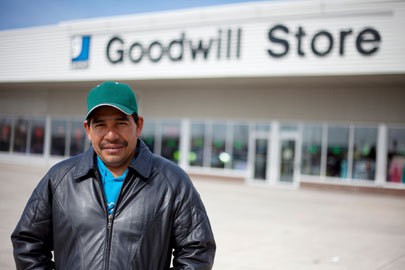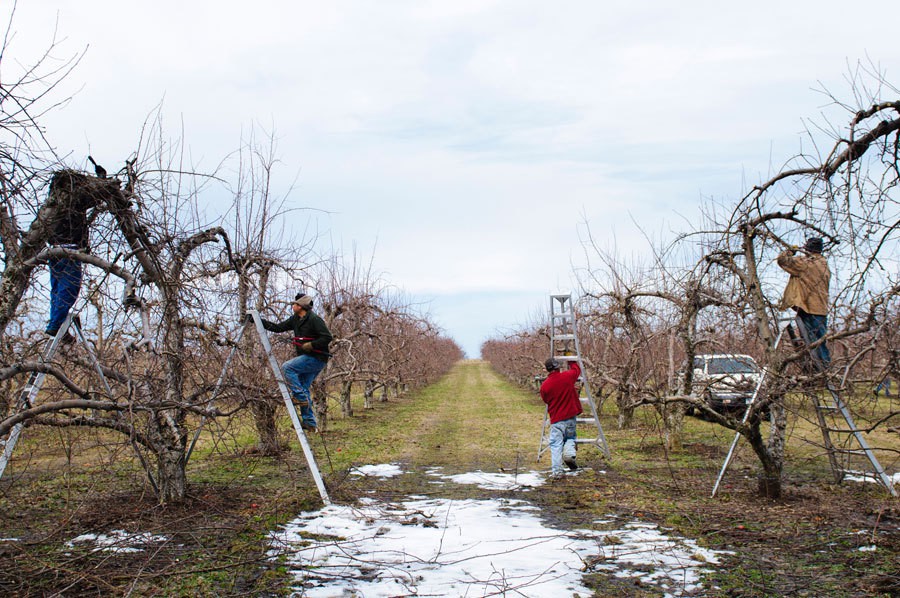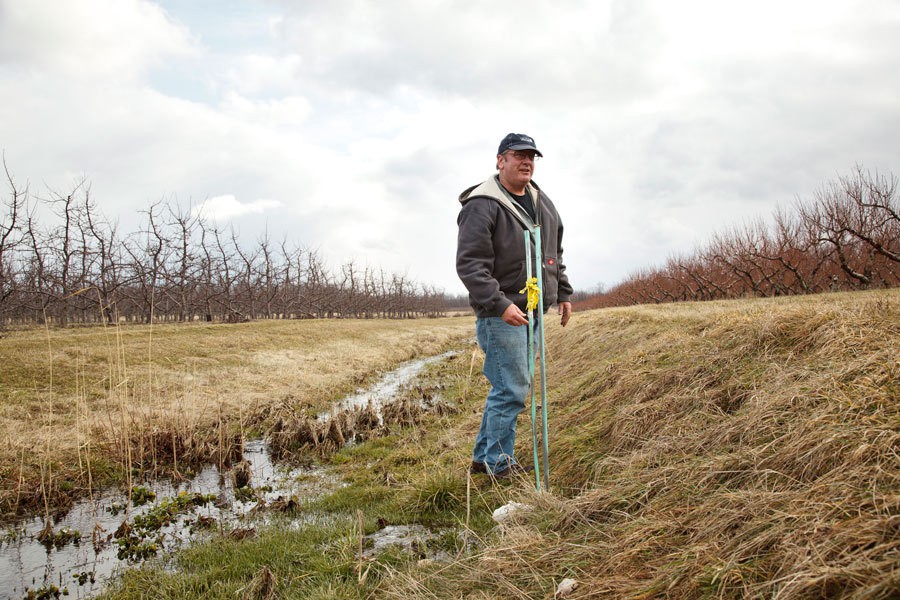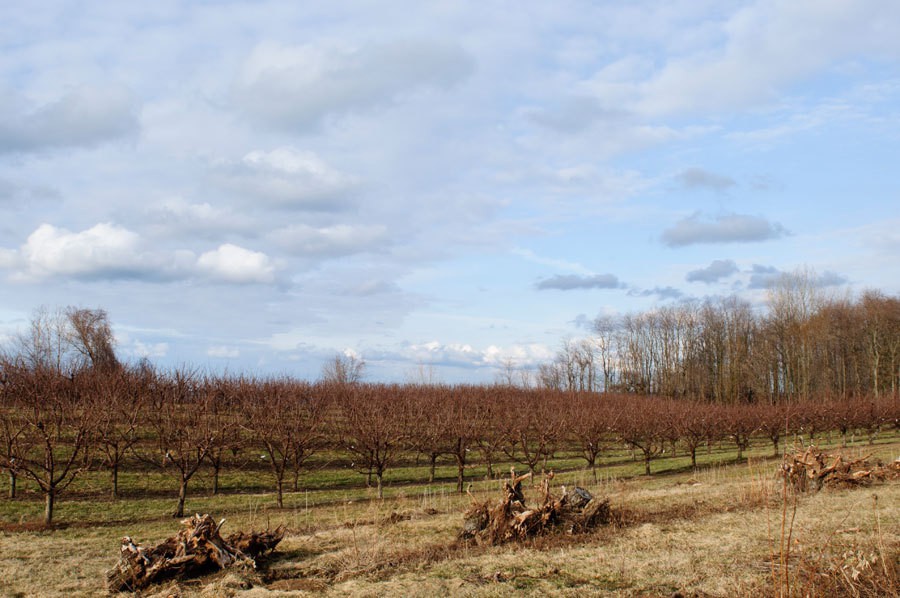Canadian Guest Worker Program Could Be Model for U.S.
VIDEO:
Canada's guest worker program has been touted as a possible model for the U.S. and has been recognized by the United Nations for its fair treatment of workers. But the program has critics in Canada and could be hard to implement in the U.S. (Video By Cassondra Strande)By Peter Haden
Cronkite Borderlands Initiative
NIAGARA&-ON-THE-LAKE, Canada — Guillermo Hernandez Alcantar was chilly.
He’d arrived in Canada from Mexico three days before. The journey brought him hundreds of miles north on the guarantee of work and stability – to pick the grapes that locals will not. He came as a legal guest worker.
“Right now, the Mexican workers have not finished arriving,” Hernandez Alcantar said on a brisk morning in March. “By May, they will all be here.”
He needed to buy a jacket, so he mounted a well-worn Huffy 10-speed bicycle – one of many leaning up against the two worker dormitories – and rode off, passing through the vineyards that stretch the length of Line 1 Road. Though he spoke little English, he knew he could get by in town without it.
The others made that clear to him, before he arrived in Canada.
A revamped guest worker program is a key element in current U.S. immigration reform proposals in the United States. The leading proposal – soon to be debated in Congress — calls for employers to recruit up to 200,000 unskilled workers a year. It would also provide a faster path for legal residency for agricultural workers if they commit to continuing to work in the fields.
But the plan is delicately balanced; business and labor say that any deviation could jeopardize comprehensive immigration reform in the United States. As Congress finds it increasingly difficult to arrive at a solution that satisfies myriad interests, Canada’s long-established Seasonal Agricultural Workers Program or SAWP, has been offered as a model of best practices.
The SAWP program, established in 1966 as a bilateral agreement between Canada and Jamaica and later expanded to include Mexico and other countries, extends eight-month contracts to individuals willing to work low-skilled agricultural jobs, with guarantees of housing, health care, wage standards and partial reimbursement for travel.
The Canadian program has been looked at by those crafting new legislation in the United States, according to Kristi Boswell, director of Congressional Relations for the American Farm Bureau Federation. She said it was a good model, except that Canada — employing an agricultural workforce of 280,000 in 2011 — had much smaller labor needs than the United States.

Guillermo Hernandez Alcantar, a Mexican agricultural worker in Ontario, Canada, says the shops in St. Catherines provide a social space where migrants meet and exchange news. Photo by Perla Farias. |
Boswell considers the current U.S. immigration system broken. The industry needs workers yet runs huge risks in employing so many undocumented immigrants. One part of the current proposal would force employers to use the federal government’s legal worker verification system – known as E-Verify. If workers did not pass the E-Verify check they would be dismissed.
“Currently, we approximate over one million hired workers in the industry of agriculture,” said Boswell. “We know, and are one industry that will admit, that a large percentage of them are undocumented — about 60-70 percent. And with the looming threat of E-Verify, we recognize that agriculture would face big economic losses in productivity if we could not access our labor force.”
Learning from the Past
A bi-partisan committee of senators – the so-called “gang of eight” – released their comprehensive immigration reform bill in April to mixed reviews. It will be a start for what promises to be tough negotiations to reach immigration reform.
The proposal is has four aims: (1) to create a path to citizenship for unauthorized immigrants currently in the country, as long as the nation’s borders are “secure” first; (2) to reform the legal immigration process; (3) to create an effective employment verification system that will end the hiring of future unauthorized workers; and (4) to establish an improved process for admitting temporary workers.
“From a policy point of view, it is critical that these things happen together,” said Muzaffar Chishti, director of the nonpartisan Migration Policy Institute office at New York University School of Law. “That’s what the ‘comprehensive’ approach is. The reason for this is that they all feed off of each other.”
Christi said unless all four goals are met the legislation will fail to address the overall immigration problem and invite all interested parties to game the system.
“Take the E-Verify part of the bill,” said Chishti. “If we just pass that, and 11.5 million people are running around the country without documentation…either they all lose jobs or people will circumvent the employment verification system. It’s not going to make E-Verify a success.”
Giving a path to citizenship to the current undocumented population without reforming the guest worker model would be equally futile, according to Chishti.
“The same is true if we ‘clean the slate’ and give 11.5 million people papers,” he said. “If people in the future don’t have a mechanism to come through legal streams… and if E-Verify won’t let employers hire them, they will just hire them off the books.”
Gregorio León remembers the effect that a patchwork immigration policy had on his father, Melquiades León – one of 4.6 million Mexicans brought to work in the U.S. between 1942-1964 under the Bracero program, the largest U.S. experiment with guest workers to date.
“Problems starting arising between 1950 and 1955 because it was too expensive for a rancher to hire people,” he said. “[T]hey had to give them housing and provide for them in order to fulfill the contract. The ranchers didn’t like that so they told people to come illegally. In those times it was very easy to cross the border – there was no wall, no waiting times – it was really easy to get in.”
Getting a new comprehensive immigration plan that can’t be circumvented will not be easy.
“From a policy point of view,” Chishti said, “it makes immense sense to do it together. It’s logical to do it together. But just because it’s logical to do it together…doesn’t mean that politics will allow it to happen together. And that’s the dilemma in our immigration debate today.”
This is a lesson that was learned the hard way.
In 1986, President Ronald Reagan signed into law the Immigration Reform and Control Act as an overhaul to the immigration system. The law made it a criminal offense for employers to knowingly hire or recruit undocumented immigrants and introduced a new program – the H-2A visa – for temporary agricultural workers. But it became better known for introducing the A-word into the American political lexicon: amnesty. Overnight, nearly three million undocumented immigrants were granted legal status.
The measure was meant to encourage growers to employ legal workers.
However, before the bill’s passage, an “affirmative defense” clause was added that released employers from any obligation to verify the authenticity of workers' documents. The incentive provided by this loophole – coupled with the well–established crossing routes a largely unsecured 2,000–mile southern border – only gave rise to a further boom in illegal immigration.
“The ultimate problem with IRCA was that it was too narrow,” said Chishti. “It took care of the existing slate and cleaned it, but it provided no workable mechanism for future flow...and that became the nucleus of the current unauthorized population.”
From 1989 to 2009, the percentage of undocumented U.S. agricultural workers rose from 14 percent to 48 percent, according the National Agricultural Worker Survey.
The Shortcomings of H-2A; The Complications of Undocumented Labor
“It is a very burdensome program that’s full of red tape…Only four percent of agriculture uses H-2A,” the Farm Bureau’s Boswell said. “It is an uncapped program – we could bring in as many workers as we want. But it is such a mess that no one uses it. That should be telling in itself.”
The program is not agile enough for many American growers, according to Chishti.
“By definition agriculture is the kind of work in which you need people to come to pick crops that may be perishable – a harvest may not last very long,” Christi said. “So you need a sort of ‘quick order’ – a quick return on the need to fill the demand for workers. And the program has not been able to do that.”
The program also gets a failing grade from human rights watchdogs. In their 2013 report "Close to Slavery," The Southern Poverty Law Center says that the H-2A program “[I]s rife with labor and human rights violations committed by employers who prey on a highly vulnerable workforce.”
Chishti said a system in which workers are beholden to one employer who has total control over them leads to abuses.
This fact is not lost on the American Farm Bureau.
“We recognize that a large percentage of our labor force would not pass an E-Verify test,” said Boswell. “I think members of Congress also recognize that, and that is largely why E-Verify hasn’t been successful at a national level.”
But the one key factor that separates Canadian employers from their southern neighbors physically also ensures that they adhere to the authorized, state–regulated guest worker program: geography.
“The undocumented pool in Canada is very small because, well, you just can’t get here easily,” said Forth. “I will never have that opportunity here because we have a 1,200-mile-wide fence called ‘The United States’. We don’t have Mexico just below us, where workers can just come over,” he said. “If a worker comes out of Mexico trying to find a job, he’s not going to get here unless we fly him here.”
Canadian SAWP model: A Bilateral Framework
Knotty pine planks run the length of Ken Forth’s Lynden, Ontario, office, providing a rustic backdrop for the abundance of framed photos and newspaper clippings hung throughout. The collection reveals two things for which he has long been recognized — stock car racing and the Canadian SAWP program.
He speaks in the declarative, no-nonsense cadence of a man who values time — a finite commodity tracked precisely in the office by a clock bearing the inscription: 1966–2006 CARIBBEAN SAWP – Congratulations on 40 years.
Forth remembers how the program got its start back in those days.
“Some farmers went to Jamaica, they saw a lot of guys with no work,” Forth said. “Then they came back home to Canada where they had a lot of work but no workers. So they put a pilot program together with the Canadian government, and we brought 264 Jamaican workers in. It was a success.”
By 1976, other countries had signed bilateral agreements to be included in the seasonal worker program — Barbados, Trinidad and Tobago, the Organization of Eastern Caribbean States and Mexico.
According to Forth, the success of the program lies in the protections afforded by the bilateral framework – for both the workers and employers. Each sending country negotiates with the Canadian government to set the objectives of the program and detail each party’s role in workers’ transportation, supervision and advocacy. The framework is designed to initially safeguard workers from exploitive recruiting practices. Once in country, liaison service officers from the sending countries monitor the migrants’ timely payment, living and working conditions and health needs.
“We want support for those workers from their own folks,” Forth said. “We have a relationship with those embassies and with their governments. Jamaica has seven people on the road every day in this province looking after their guys. If there is an issue on the farm, if there is an issue at home, they’ll help resolve it. If there is an argument between workers, they’ll come out and iron that out. If there is a problem between an employer and a worker, they can help with that.”
The guest worker proposal included in the new U.S. immigration reform bill, however, includes no such framework.
The American Farm Bureau anticipates that, in the long run, their entire agricultural workforce will come from the new program. The scope is too large to implement bilateral agreements, according to Boswell.
“We think of our program as not bilateral,” said Boswell. “They could come from anywhere. I think there are South American countries that would avail themselves of a workable program. I think ultimately it would be any workers that wanted to come into this country to provide better for their family, who could do that better with a temporary job in the United States than in their home country.”
Canada does have another agricultural guest worker program in addition to the SAWP – a non–seasonal model called the Temporary Foreign Workers agricultural stream – established in 2002 for low-skill occupations including production of commodities that are not seasonal in nature, like year-round greenhouse flowers and mushrooms. Under TFW, employers can bring workers from any country for up to 24 months at a time, without a standard employment contract. The number of workers coming into the TFW program is much smaller, 7,500 workers in 2012 compared with 30,000 in SAWP, but its use is increasing.
In Forth’s view, there are real issues in allowing a free flow of workers coming from any nation.
“When the low-skilled programs came in around 2000, some of us in this program were talking to the government about it because we thought they were going to take the SAWP and put a lot less requirements on it than we had,” Forth said. “We profanely objected to that.”
Forth said that TFW, like H2-A in the United States, provides no recourse for workers who get sick, hurt or abused on the job. Neither does it provide a way for employers to easily correct problems.
“There is nobody those people can call, and that makes us uneasy,” Forth said. “We don’t want that. In the SAWP program, if we have an issue with one country, we can call their Ministry of Labor. We can call those people and say, ‘You know what? This is off the rails here – we’ve got to get this fixed.’ That’s why we don’t want to deal with all the countries of the world. It would be a mess and we wouldn’t have a relationship.”
The involvement of liaison representatives from supply countries has been key to the SAWP model, according to Henry Neufeld, manager of agriculture programs for Human Resources and Skills Development Canada, the government department that oversees the temporary worker programs.
“In my opinion,” he said, “it has been the single most successful and productive role that anybody has played and has lent itself to the program being as successful as it is.”
Criticism of Canadian Guest Worker Models
The Canadian models, however, are not without criticism. Labor advocates say the SAWP program guidelines that tie migrants to a single employer create a fear of reprisal if a worker complains and that the TFW program has a deep lack of oversight and is open to exploitive recruiting practices within the sending countries.
Both programs are flawed, according to Stan Raper, national representative for United Food and Commercial Workers Canada.
“Both programs assume that the employers are good. Both programs assume that there is provincial or federal regulation and enforcement that will assist these workers,” Raper said. “I say ‘assume’ because the reality on the ground is not showing that.”
Raper said that if complaints are filed, federal regulators pass the buck to provincial regulators who say they don’t have any money to enforce the agreements.
“And so you go around and around. The only real change that has been made to the programs over the last seven years has been expediting the process for employers,” Raper said. “No monitoring and enforcement, no acknowledgement that there are even any problems.”
But Forth argues that every year, farmers, representatives from the Canadian government, the sending countries and their liaison services, all sit together and go over problems with the SAWP program. And the problems are few.
“We don’t have anything to hide. And this program doesn’t have anything to hide,” Forth said. “It’s the best darn program on the planet. You hear of other temporary worker programs…but they don’t run like this one. They just don’t. I’ve made speeches about this program at the United Nations in New York and at the I.L.O. [International Labor Organization] in Geneva, and people are going, ‘I can’t believe it. I can’t believe it. I can’t believe you have all of those checks and balances in place.’ Does it work perfect? No. Does it work almost perfect? Yes, it does.”
Raper disagrees.
“What we have is a growth industry of cheap, exploitable labor coming into Canada,” Raper said. “And we’re saying, ‘We need to make some revisions’. Yes, the ag sector may need workers. But it’s how they’re treated. Do they have a path to citizenship? Should they have occupational health and safety standards? There are all kinds of flaws. And there is no political will at this point to change that.”
Better than the Alternative: Providing Opportunity
Juan Perez Xiloj looks forward to seeing the reincarnated white U–haul truck ramble up the driveway each week, loaded with tortillas, tropical fruits and coconut water not easily found in the shops around St. Catherines, Ontario. Like the other Guatemalan guest workers on the farms in this area, he takes his turn squeezing into the cramped box to snatch up some comforts from home.
Perez Xiloj and the others work in the Canadian TFW program, picking and pruning flowers for Mother’s Day bouquets and wedding arrangements that will be delivered throughout North America. It’s an easy commute to work – the floral greenhouses stretch out just across the road from the twin white bunkhouses that the workers call home.
“Yeah, it’s beautiful,” Perez Xiloj said. “It’s comfortable, it’s good. It’s close to our job. When I worked in Quebec, my workplace was 30 minutes away. But here – it’s close. We go out in the morning, we go to our job and from work back to home.”
He said the program offers him opportunities that don’t exist in Guatemala, where he had work selling chiles in a market.
“It’s vastly different. In Guatemala I earn 100 quetzales [$13] a day, but it’s not enough for my kid’s studies,” Perex Xiloj said. “So when this job came open, I thought it would be better for me here. Hopefully, I can continue doing it for as long as I can.”
He appreciates the structure of the Canadian system and says it would be a good program for the U.S. to model.
“The migrants there — they have no papers, no passport, no visa, nothing,” he said. “We have visas, passports, health insurance, everything. So… we feel safer because we can go out in the street, and if a cop comes, we know that nothing happens. We’re safe. We come on an airplane and we leave on an airplane.”
The floral greenhouses are just one stop on the route Elda Boniche’s drives with her mobile store. She started the delivery service in 2009, importing food and snacks familiar to the migrant workers and delivering them once a week to the rural clusters where they live.
 SLIDESHOW: Elda Boniche says goodbye to guest workers at floral greenhouses near Jordan, Ontario, Canada, before continuing on her route. March 10, 2010. Photo by Peter Haden. |
“We go to the farms with the truck because they don’t have transportation out there,” said Boniche. “They come to town once a week to shop, but in the local supermarkets they’re not going to find the products that we offer them – tortillas, chili peppers, Jarritos [Mexican sodas] – basic products that make them feel connected to their home countries. Since they are so far away, we have to go to them – and we can arrive with our products at their front door.”
The 10-foot GMC box truck is a fairly recent upgrade. She didn’t always have so much space.
“At first,” said Boniche, “I didn’t have the means for a truck…so I just started with my car. Afterward I bought the truck, and after that we started with the store – just a little over a year ago in 2011.”
Boniche is no stranger to the circumstances facing the migrants. She arrived in Ontario in 2002 from Costa Rica, her five children in tow.
“Like all immigrants, I came to look for better opportunities for my children,” she said. Over the next 11 years, she picked fruits in the fields, cleaned offices, worked in factories and in call centers. Then, in 2008, while recovering from a spine injury incurred during a fall, Boniche came up with the route idea.
“Delivering to the farm workers opened the doors for me to bring revenue to my home and have a job source,” Boniche said.
She says that the Canadian programs offer migrant workers an opportunity they would not otherwise have.
“Many of them don’t have a career, they don’t have a way to make money in their country,” Boniche said. “They come and work here to pay for the higher education of their children. So, if we look at it from the social aspect of their home countries, there will be more professionals and they’ll have kids and grandkids with a better way of life.”
She thinks the Canadian models would be ideal for the United States.
“I hope that this reaches Obama’s ears and all those who are politically involved,” Boniche said. “I think every day, ‘A lot of people are crossing the desert, how many people are suffering?’ How many people crossed and walked and came with a dream that got left behind in the desert, stranded and didn’t even have a dignified funeral? I think that a program like this helps so that instead of arriving to be exploited, workers arrive with a job that gives them another life option.”
For the workers, it’s not just about survival, according to Forth. It’s about investment. This is their access to capital.
“One guy said, ‘That’s how I get my money,” Forth said. “I come up here to raise money, and I go back to buy another business. These guys are a lot more than just workers. Lots of them are very entrepreneurial.”
He says the bonds he has with his workers are strong:
“It’s a great relationship we have with them. And it’s sad when the guy says, ‘I’m not going to come anymore’, because you know them. They’ve built their house and they’ve educated their kids. And that would not have been possible if they weren’t here.”
And even without a mandatory requirement for the workers to return to their sending countries, Forth thinks the majority of workers would choose to return to the familiarity of home.
“There are some people that have a huge Canadian ego and think everybody wants to live in Canada. Everybody does not,” Forth said. “One guy worked for me for 29 years. I said, ‘Lloyd, would you ever want to live here?’ He said, ‘If I’d wanted to live here, I’d have run away 25 years ago. I’ve got a good thing going. I work here six or seven months and I go home to my wife and I build a nice house and I have a nice family and I have a nice life.”
“’And besides,” Lloyd told Forth, “it’s too cold here.”
Back to Top







